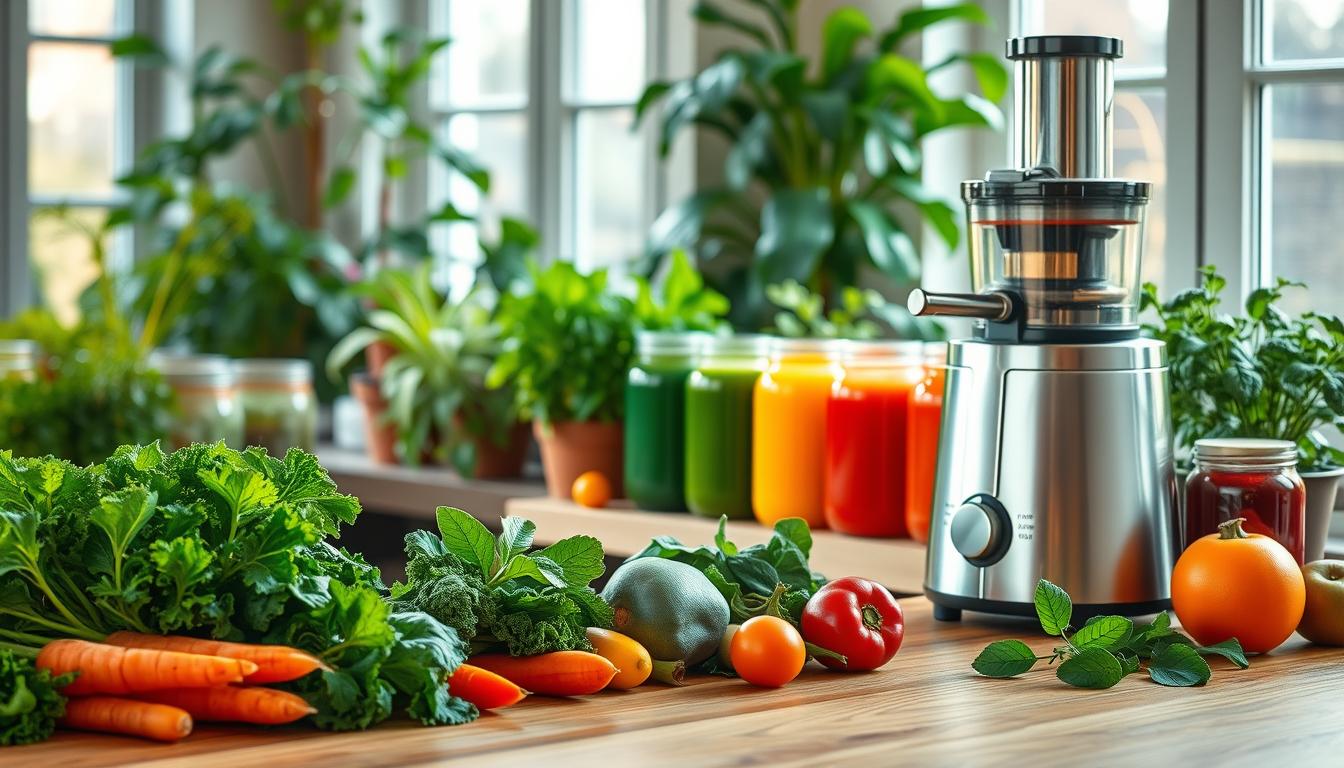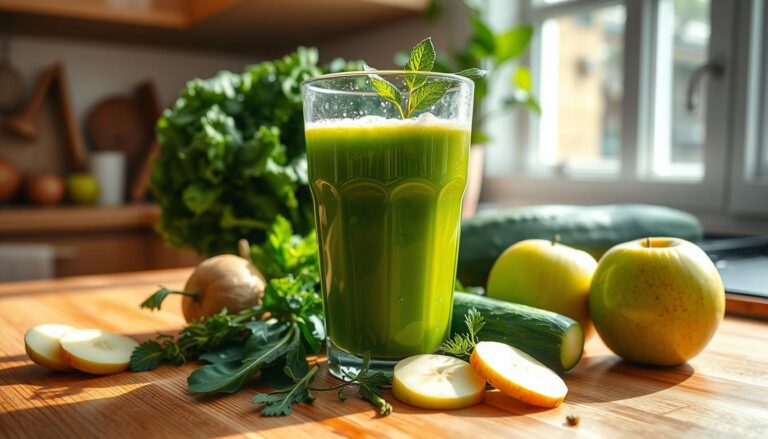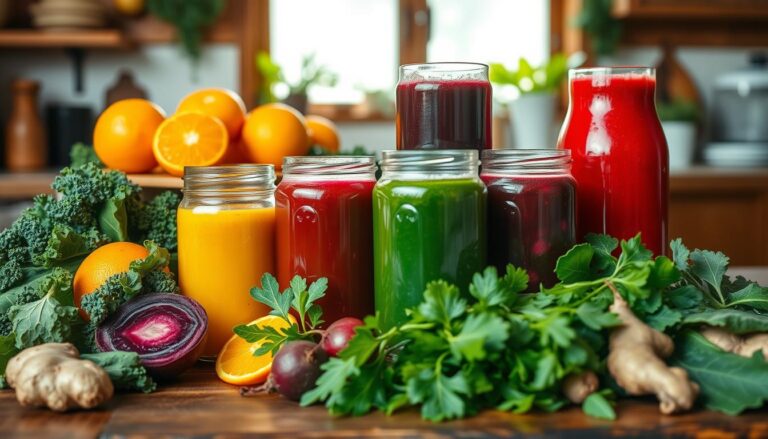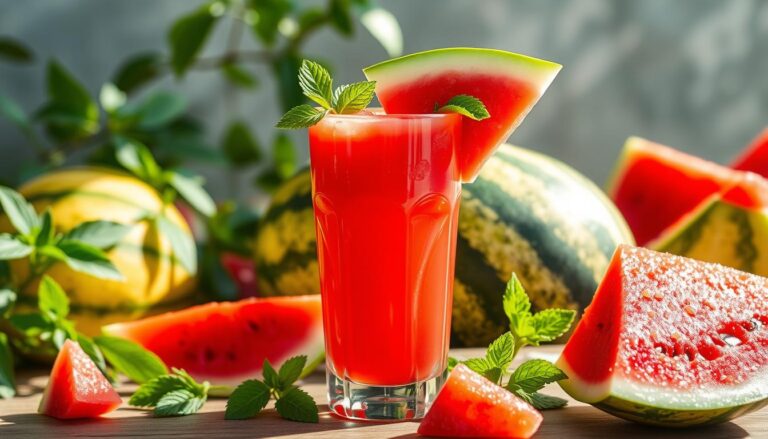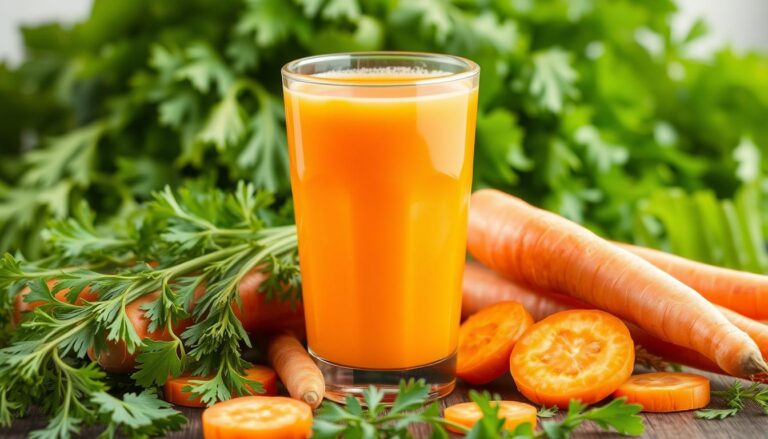Delicious Juicing Recipes for Alkaline Diet
Imagine drinking a refreshing green juice that makes your body feel alive. This is what an alkaline diet offers. It uses juices full of nutrients to balance your body’s pH and give you energy. These juicing recipes for alkaline diet are easy to make and help you feel great.
Start with simple recipes like celery, cucumber, and apple. They are great for beginners. You’ll soon notice you have more energy and feel less inflammation.
Imagine a glass of vibrant juice that helps your body stay in balance. Dr. Sebi suggests juices like greens or Mango, Orange, and Strawberry Mocktail. These juices are full of nutrients and help your body digest food better. They also boost your immune system.
These juices are made to be quickly absorbed by your body. You might see clearer skin and feel less hungry. Plus, you get to enjoy flavors that are as natural as they are delicious.
Table of Contents
Understanding the Alkaline Diet and Why Juicing Matters
Your body works hard to keep its pH balanced. But, modern diets with processed foods and animal products can make it acidic. The alkaline diet focuses on foods that reduce acid load, supporting natural pH balance. Let’s break down how this works—and why juicing plays a key role.
The Science Behind pH Balance in Your Body
Your blood stays slightly alkaline (pH 7.2–7.4), but daily choices matter. Acid-forming foods like meat and sugar can strain your kidneys. Leafy greens and veggies, when metabolized, leave alkaline residues that help your body stay in equilibrium. Whole foods are ideal, but juicing makes their nutrients more accessible.
How Juicing Enhances Alkalinity
When you juice, you concentrate nutrients from alkaline-rich foods like spinach, celery, and cucumber. This liquid form lets your body absorb vitamins and minerals faster than eating raw veggies alone. To maximize how to juice for an alkaline diet, focus on:
- Leafy greens (kale, spinach)
- Low-sugar veggies (celery, broccoli)
- Avoid citrus—its acidity isn’t what determines a food’s metabolic residue
Health Benefits of an Alkaline-Rich Diet
Research suggests the benefits of juicing on an alkaline diet may include reduced inflammation and better energy. By prioritizing plant-based nutrients, you support digestion and immunity. But, balance is key—always pair juices with whole foods to get fiber and protein. The USDA advises 5–7 ounces of protein daily, so pair your green juice with plant-based sources like tofu or legumes.
Essential Equipment for Your Alkaline Juicing Journey
Starting your alkaline juicing routine doesn’t need a full kitchen makeover. Focus on tools that make making nutrient-rich drinks easy. A good juicer or blender lets you easily include alkaline foods in your juicing routine like spinach, beets, and apples.
“Begin with what you have. Even store-bought juice can work when blended with fresh greens!”
Compare these juicer types to choose your starter kit:
| Type | Centrifugal Juicer | Masticating Juicer |
|---|---|---|
| Price Range | $50–$200 | $200+ |
| Speed | Fast but heats ingredients | Slower, preserves nutrients |
| Best For | Soft fruits and veggies | Leafy greens and hard roots |
No juicer? Use a high-powered blender like Vitamix to puree ingredients. Strain the mix through a mesh sieve to mimic juice texture. Pair with alkaline-friendly foods like cucumbers or celery for balance. Always prioritize how to juice for an alkaline diet by focusing on freshness—store-bought options are a practical backup.
Invest in sturdy cutting tools and airtight containers to keep juice fresh up to 24 hours. Start small: even a blender and strainer set lets you experiment without big costs. As you advance, consider a masticating model like Hurom for optimal nutrient retention.
Top Alkaline Foods Perfect for Juicing
Choosing the right ingredients is crucial for juices that support your pH balance. Focus on alkaline foods in your juicing routine. This way, you get more nutrients and less acid. These foods give you minerals like potassium and magnesium, helping keep your body balanced.
Leafy Greens and Their Alkalizing Properties
Leafy greens are the heart of many alkaline juices. Spinach, kale, and Swiss chard are full of nutrients that help balance your body. They also have minerals that fight acidity:
- Spinach: High in iron and folate
- Kale: Loaded with vitamin K and fiber
- Swiss chard: Supplies magnesium and vitamin E
Adding a handful of greens to your juice gives you a big mineral boost.
Fruits That Support Alkaline Balance
Citrus fruits like lemons and limes turn alkaline after digestion. They add a tangy flavor without upsetting your pH levels:
- Lemons: Pair with celery for a refreshing kick
- Pineapple: Adds natural sweetness and enzymes
- Apples: Blend with greens to balance flavors
“Lemons’ alkaline ash neutralizes acidity when metabolized,” says nutrition experts. Use them in alkaline juicing ideas like lemon-celery combos.
Roots and Vegetables for Alkaline Juicing
Vegetables like cucumber and celery add hydration and nutrients. Beetroot and carrots bring earthy flavors and phytonutrients:
- Celery: Rich in electrolytes and sodium
- Beets: Boost nitrate levels for energy
- Carrrots: Add beta-carotene and natural sugars
Try mixing cucumber with mint and apple for a refreshing drink.
Morning Energy Boost: Juicing Recipes for Alkaline Diet
Start your day with best alkaline diet juicing recipes that boost energy and balance pH levels. These alkaline juice blends are made with fresh fruits and veggies. They give you vitamins and minerals and help detoxify your body. Here are three simple recipes to try.
| Recipe | Key Ingredients | Benefits |
|---|---|---|
| Green Goddess Morning Elixir | Spinach, kale, apple, lemon, ginger, cucumber, celery | Rich in chlorophyll, supports digestion, and provides electrolytes balance. |
| Citrus Alkaline Sunrise Blend | Lemon, orange, celery, fennel, parsley, apple, ginger | Packed with vitamin C, aids hydration, and enhances immune function. |
| Cucumber Mint Refresher | Cucumber, mint, lime, celery, apple, spinach, fennel | Hydrates the body, reduces inflammation, and promotes mental clarity. |
Here’s how to make any blend:
- Wash and chop ingredients into juicer-friendly pieces.
- Process ingredients through a masticating or centrifugal juicer.
- Drink immediately or store in a glass jar for up to 24 hours.
Pro tip: Add ½ tsp of himalayan salt to any juice for electrolyte balance. Swap apples with pears in alkaline juice blends to adjust sweetness. Most recipes need 6-7 ingredients and take less than 10 minutes to make. Use this chart to keep track of your favorite recipes:
| Storage Method | Time Frame | Tip |
|---|---|---|
| Refrigerated jar | 12-24 hours | Strain pulp for longer shelf life |
| Freeze in ice cube trays | 1 month frozen | Thaw overnight before drinking |
Enjoy these best alkaline diet juicing recipes with a light breakfast for lasting energy. Use in-season citrus for the best flavor.
Detoxifying Alkaline Juice Blends for Cleansing
Looking for an alkaline juice cleanse recipe? Choose ingredients that help your liver and kidneys. Beets, ginger, and leafy greens are great for cleaning your cells. Start with a 48-hour cleanse, but remember, these juices are meant to complement whole foods, not replace them.
- Healthy Skin Juice: Blend 2 cups beetroot, 1 cup carrot, and ½ lime. Beetroot’s betalains and carrot’s carotenes flush toxins while boosting skin repair. Drink within 6 hours for peak nutrient absorption.
- Tarzan Juice: Combine 2 cups spinach, 1 apple, and 1-inch ginger. Its low salicylate profile makes it ideal for sensitive systems. Ginger’s enzymes enhance digestion, aiding nutrient uptake.
- Purple Carrot Juice: Mix purple carrots, 1 tsp apple cider vinegar, and celery. Anthocyanins in purple carrots neutralize free radicals, while ACV supports alkalinity.
Dr. Sebi’s Small Cleansing Package uses mung bean sprouts and dandelion greens to stimulate bile flow. Users report reduced inflammation and allergy symptoms within days. Always avoid kale if you have thyroid issues—opt for spinach instead.
These recipes aren’t a standalone cure. Pair them with hydration and light meals. Alkaline juices ease digestion, freeing energy for immune processes. Note: most initial weight loss (1-3 lbs) comes from water and glycogen, not fat—focus on long-term benefits.
Nutrient-Dense Alkaline Juices for Immunity
Your immune system needs nutrients found in alkaline juice blends. These recipes use ingredients that balance pH levels to boost your immune function. Leafy greens and citrus are key, as they support cellular health.
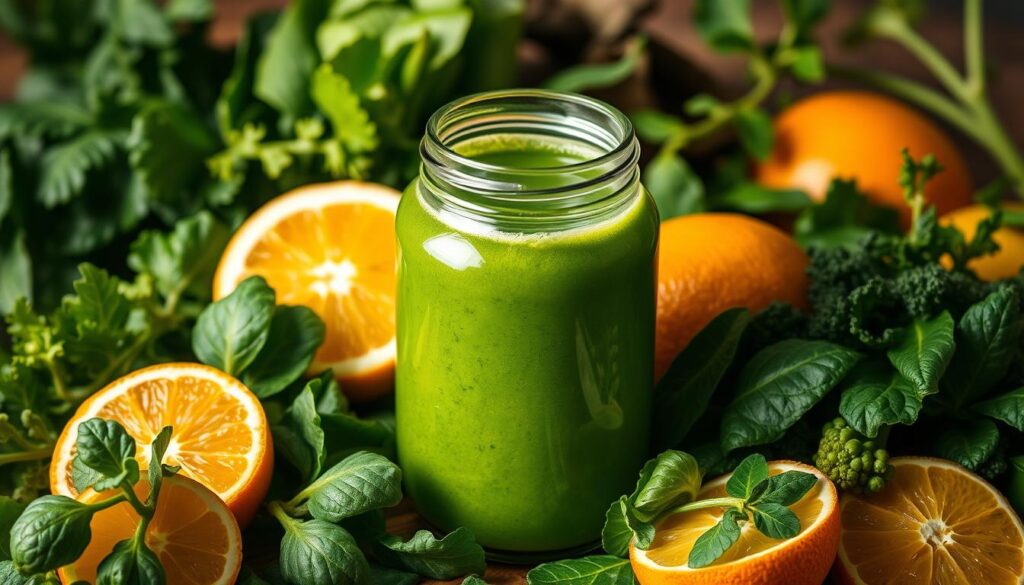
The World Health Organization suggests eating 400g of fruits and veggies daily. These juices help you meet that goal.
Ginger Turmeric Immunity Booster
Spice up your immunity with this anti-inflammatory mix. This juicing recipe for alkaline diet uses black pepper to boost turmeric’s bioavailability. Prep time: 10 minutes. Ingredients:
- ½ cucumber
- 4 celery stalks
- 1 apple, cored
- 1-inch ginger chunk
- ½ lemon (peeled)
- 1 tsp turmeric powder
- A pinch of black pepper
Blend all ingredients. Ginger and turmeric reduce inflammation. Lemon adds 53mg vitamin C per medium lemon, boosting immune response. Black pepper unlocks turmeric’s anti-inflammatory benefits.
Berry Alkaline Antioxidant Mix
Combine antioxidant-rich berries with greens for pH balance. This blend uses blueberries and spinach to boost vitamin C and fiber. Key ingredients:
- ½ cup strawberries
- 1 cup spinach
- ½ cucumber
- 1 lemon’s juice
Blueberries provide antioxidants, while spinach adds iron (2.7mg per 100g). The NHS reports only 25% of adults meet fruit/veggie goals—this mix helps close the gap. Pair with greens to balance pH levels.
Leafy Green Defender Juice
Dark leafy greens like spinach and kale boost immunity with minerals. This 200-calorie blend includes:
- 2 cups spinach
- 1 cup kale
- ½ apple
- ½ lemon
- A dash of celtic sea salt (for minerals)
Spinach offers 2.7mg iron per 100g, while kale provides vitamin K. The 20g fat per serving supports nutrient absorption. Studies show alkaline greens enhance immune cell function.
These recipes align with WHO guidelines for nutrient intake. Users of Dr. Sebi’s Small Cleansing Package report reduced allergy symptoms after incorporating these blends. Adjust portions for taste preferences, but keep the alkaline pH balance intact.
| Recipe | Key Ingredients | Immune Benefits |
|---|---|---|
| Ginger Turmeric | Cucumber, turmeric, black pepper | Anti-inflammatory, enhanced nutrient absorption |
| Berry Mix | Blueberries, spinach, lemon | Antioxidants, vitamin C |
| Leafy Green | Spinach, kale, apple | Iron, vitamins A/C/K |
How to Incorporate Alkaline Juicing into Your Daily Routine
Starting with alkaline juicing is easy. Just take small steps. Here are tips to make fresh juices a part of your meals. They help keep nutrients fresh and balanced.
Creating a Sustainable Juicing Schedule
Find a juicing plan that works for you:
- Daily: Start with 1 juice daily, like a quick morning green blend.
- 3-4x weekly: Pick mornings or post-workout days for energy.
- Weekly boosts: Use on busy days with prepped ingredients.
Prep veggies and fruits ahead to save time. Always include leafy greens and low-sugar fruits for optimal alkalinity.
Storage Tips for Maximum Nutrient Retention
Keep nutrients fresh with these methods:
| Method | Storage Time | Tips |
|---|---|---|
| Refrigeration | 24-48 hours | Use glass jars; add lemon juice to slow oxidation. |
| Freezing | 3 months | Use ice cube trays for quick servings. |
| Vacuum-sealed | 72 hours | Pick airtight containers for best freshness. |
Balancing Juicing with Whole Foods
Combine juices with meals for full nutrition. Alkaline smoothie recipes for juicing add fiber—try this quick blend:
- 1 cup spinach
- ½ banana
- 1 tsp Alkalizing Super Greens Powder (use code for $10 off)
- ½ cup almond milk
Pair with salads or steamed veggies for sustained energy. Smoothies recipes retain fiber, aiding digestion while supporting pH balance.
Common Mistakes to Avoid When Juicing for an Alkaline Diet
Learning how to juice for an alkaline diet means avoiding simple mistakes. Many people miss out on key steps that can hinder their progress. Here are some common errors to steer clear of:
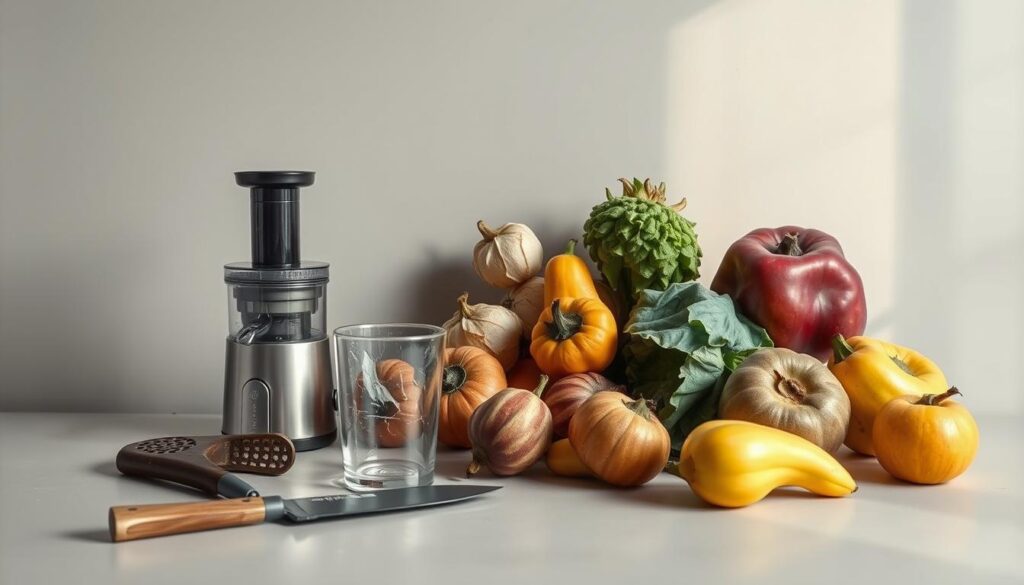
“Greens are great because you really can’t have too many of them. I recommend adjusting the amount of green powder you use based on your personal preference.”
- Overloading with fruit: Too much sugar from fruits like apples or mangoes can raise insulin levels. Limit sweet ingredients to one per juice and focus on leafy greens like spinach or celery.
- Skipping green rotation: Eating the same greens every day can lead to too much oxalate. Mix it up by using kale, collards, and romaine greens weekly.
- Poor storage habits: Juice oxidizes quickly. Drink it right away or store it in airtight containers within 15 minutes. Use slow juicers like the Omega J8006 for up to 24 hours.
- Ignoring pulp: Don’t throw away pulp! Use it in smoothies or veggie burgers to reduce waste and increase fiber.
| Mistake | Fix |
|---|---|
| Too many acidic ingredients | Balance with alkaline greens like cucumber or celery |
| Forgetting to hydrate | Drink filtered water alongside juice for optimal absorption |
| Skipping meal planning | Prep 3-5 top juicing recipes for alkaline foods weekly to stay consistent |
Drink juices with whole foods like chia seeds or avocado for fullness. Store pulp in the fridge for 2 days for future meals. Always wash produce well—peel citrus fruits and scrub veggies to remove pesticides. For best results, drink juice 2 hours after meals or 20 minutes before to align with digestion timing. Making these small changes helps you stay on track with your alkaline goals.
Conclusion: Transforming Your Health One Alkaline Juice at a Time
Alkaline smoothie recipes for juicing are a simple way to boost your health. They use nutrient-rich ingredients like leafy greens, fruits, and root vegetables. By choosing alkaline juices like the Green Goddess or Citrus Sunrise, you help your body’s pH balance.
These drinks give you minerals like potassium and magnesium. Studies show these minerals help keep bones strong and lower disease risks. Modern diets often lack these nutrients, but fresh juices can help.
Research shows alkaline diets may improve kidney function and bone health, mainly with plant-based foods. While there’s no proof they prevent cancer, they do help with digestion and skin clarity. Start with a daily green juice or try alkaline smoothies during fasting.
These habits can improve mental clarity and nutrient absorption, even with vitamin D. Alkaline juicing ideas are about trying new things, not perfection. Use seasonal produce and blend recipes to your liking.
Focus on fresh ingredients, as they keep nutrients alive. Pair juices with whole foods for a balanced diet. Every glass of alkaline juice helps your health and immune system. Choose juices that energize you and fit your goals. Your health improves with every sustainable choice, one juice at a time.
FAQ
What is the alkaline diet, and how does juicing fit into it?
The alkaline diet aims to balance your body’s pH levels. It focuses on eating more alkaline foods and less acidic ones. Juicing makes it easy to get these nutrients quickly.
What are the best alkaline foods for juicing?
Great alkaline foods for juicing include spinach, kale, and fruits like lemons and limes. Also, cucumbers and celery are good. These ingredients help make tasty, healthy juices.
How can juicing benefit my health?
Juicing can boost your energy, improve digestion, and reduce inflammation. It also strengthens your immune system. Fresh juices provide essential nutrients for your health.
How often should I juice for an alkaline diet?
How often you juice depends on your lifestyle and diet. Some juice daily, while others do it a few times a week. Find a juicing schedule that fits you.
Do I need a special juicer for creating alkaline juices?
You don’t need a special juicer, but it helps. You can also blend and strain or buy juice bases to add to. This way, you can still make alkaline juices.
Are there any mistakes I should avoid when juicing?
Avoid using too much fruit, which can be high in sugar. Don’t forget to wash your produce well. Also, don’t rely only on juices. Mix them with whole foods for balance.
Can I store my alkaline juice for later use?
Yes, you can store juices for a short time. Use the right containers and keep them cold. Try to drink them within 24-48 hours for the best nutrients.
What are the benefits of using leafy greens in my juices?
Leafy greens like spinach and kale are full of minerals like potassium and magnesium. They also have vitamins, antioxidants, and fiber. These nutrients help keep your body alkaline and healthy.
How do I make my juices taste better?
To make your juices taste better, try sweeter fruits, herbs like mint, or a splash of lemon or lime. Mixing sweet fruits with greens can make your juices delicious.

